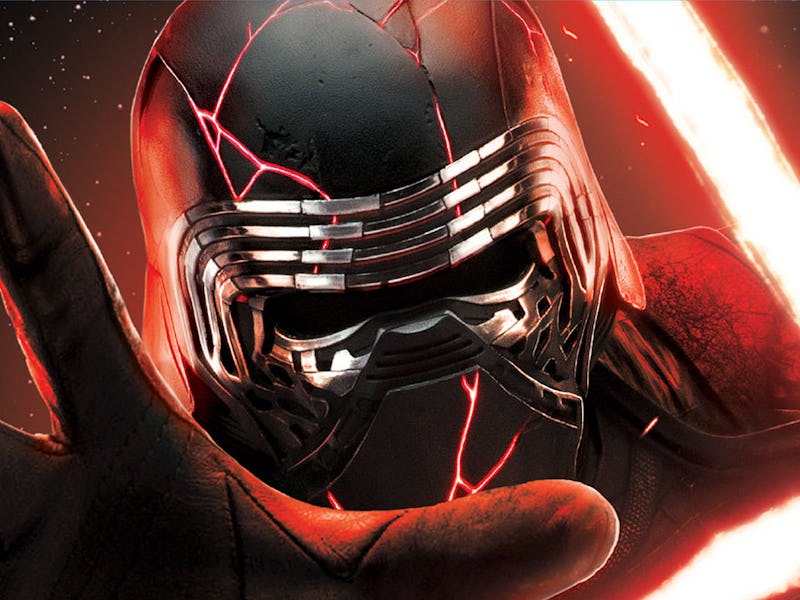Kylo Ren's 'Rise of Skywalker' helmet is wildly impractical, says armor expert
Looks great, protects nothing.

The Rise of Skywalker is finally here, bringing with it the return of Kylo Ren’s nouveau-Vader helmet, shattered during a Last Jedi tantrum. In the months leading up to the release of Episode IX, keen-eyed fans compared the visible red cracks on Kylo’s helmet to the Japanese practice of kintsugi, or mending broken objects with visible seams of gold or silver, transforming a break into a unique design element.
"If something hit the helmet, it would crack open at the same areas again.
It’s part of the franchise’s long tradition of borrowing the eye-catching design motifs of sixteenth-century Japanese armor: from the masks worn by Death Vader and Kylo Ren, to intricately layered Jedi robes. But is there any precedent for a kintsugi helmet like Kylo’s in the samurai tradition? We asked an expert to find out, and the answer is: Not really, and it’s a pretty dumb idea.
Markus Sesko, Visiting Researcher for Japanese Arms and Armor at New York’s Metropolitan Museum, tells Inverse that some elements of Kylo Ren’s armor are in keeping with Japanese tradition.
“Sixteenth-century samurai also wore full-face masks,” he says, “though mostly it was half-masks that cover everything below the nose.”
But Sesko adds that no samurai worth his salt would attempt to re-use a busted helmet like Kylo’s. It might look pretty spiffy, but it would be utterly impractical in a battle.
“It was used on ceramics and other things, but helmets were never repaired with kintsugi. It would render it too fragile to be used,” Sesko says. “If something hit the helmet, it would crack open at the same areas again.”
The notion that the helmet is more symbolic than functional seems to be in keeping with the intention behind its design. Back in September, Abrams told U.K. film mag Empire that Kylo’s Rise of Skywalker aesthetic was indeed inspired by kintsugi.
“Having [Kylo Ren] be masked, but also fractured, is a very intentional thing,” he said. “As fractured as Ren is, the mask becomes a visual representation of that. There’s something about this that tells his history.”
In other words, Kylo’s affinity for Rey and misgivings about betraying his parents continue to shape his character arc in The Rise of Skywalker. As Sesko put it, those previous weak points are likely to be where he will “crack open” again.
However, it’s the Knights of Ren whose armor most closely approximates that of a typical samurai. Sekso points out a similar example, shown below.
“This helmet bowl consists of three or four plates, and would be worn by an ordinary soldier,” he says. “A simpler version of that would be what we call a “war hat,” which is made out of iron.”
The Japanese “head-shaped helmet” (zunari-kabuto) emerged in the 16th century amid the need to simplify helmet construction in order to equip larger armies. It consists of only a few large plates which form the bowl, similar to that of one of the Knights of Ren.
A photo from Empire shows the Knights of Ren wearing similar helmets, although soldiers in sixteenth century Japan wouldn’t have had those protruding metal plates on the side.
Another one of Kylo’s mysterious henchman also wears a more practical, unadorned helmet and surcoat that evoke traditional Japanese designs.
The armor of the Knights of Ren, shown here in a behind-the-scenes photo from Vanity Fair, takes some design cues from that of typical Japanese samurai.
“In the behind the scenes photo, the person in the background to the left is wearing a helmet with a prominent neck guard,” Sesko says. “The front part reminded me — with some imagination — of the visor (mabisashi) of a Japanese helmet.”
The lines of this seventeenth-century iron and lacquer helmet are similar to that of the leather headpiece worn by one of the Knights of Ren.
The Rise of Skywalker might not reveal much about the Knights of Ren, but there’s no question that their costume design was heavily influenced by Japanese history and culture.
Even dating back to the original Star Wars in 1977, fans and critics have found plenty of reasons to draw comparisons between a galaxy far, far away and samurai stories. George Lucas has frequently discussed the influence of famed Japanese director Akira Kurosawa’s work on his own creative process, and 1958’s The Hidden Fortress was a particular source of inspiration for the first film.
It’s fair to assume Japanese history buffs will find even more references and homages to samurai traditions in The Rise of Skywalker. But we’ll probably have to wait for the home video release to discover all those Easter eggs.
Star Wars: The Rise of Skywalker is in theaters now.